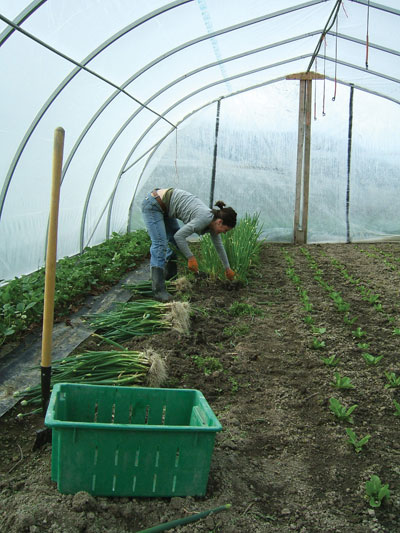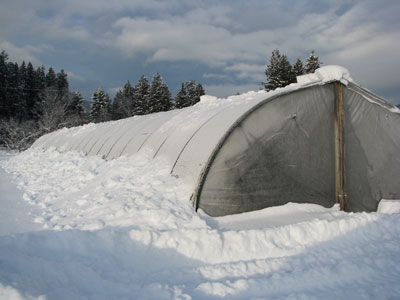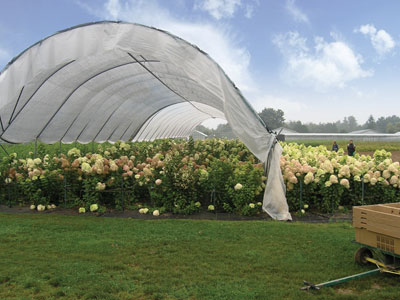
Features
High Tunnels
Structures & Equipment
High tunnels a growing option
June 20, 2011 By Treena Hein
High tunnels provide many of the benefits of a greenhouse but with much
reduced cost, and their use is allowing some greenhouse operators to
capture profits from additional markets.
High tunnels provide many of the benefits of a greenhouse but with much reduced cost, and their use is allowing some greenhouse operators to capture profits from additional markets.
 |
|
| Harvest time in a Wildflight Farm high tunnel Advertisement
|
Smit Nursery Ltd. in Abbotsford, British Columbia, is one of them. The cut flower business added several high tunnels to its existing four rolling greenhouses six years ago. “We use the high tunnels to help schedule cut flower harvesting earlier and later, when prices are best,” says Pete Smit, who co-owns the nursery with his brother Gerard. “They allow us to harvest two weeks earlier, and we also use them to get a secondary crop of perennial flowers.” The Smits remove the plastic every fall, and move the tunnels over the flower crops that will be flowering the coming year, then put the plastic back on in February or March.
SEASONAL OR YEAR-ROUND STRUCTURES
■ Tunnel models like these require plastic removal in the fall because they’re not designed to tolerate any snowfall, while others are designed so that the plastic can be left up all year round.
 |
|
| For some units, snowfall is no problem. |
The cost of tunnels depends on this and other factors, such as whether the sides are rolled up by hand or hand-cranked, which tunnel-end options are selected, and the type of frame (see sidebars to begin your research). Smit says the return on investment for a business similar to theirs is reached within two years, assuming average weather and temperatures.
Ivy Acres in Long Island, N.Y., is another operation that has added 22 tunnels to its 25 acres of greenhouses for the 2010 season.
“We mostly grow annuals for Home Depot,” says facilities manager Jim Hodun. “Our business season was very short – by around June 1, everything was sold – so we purchased these tunnels to grow petunias and other hardier plants throughout the season at low cost.”
The petunias were planted in March 2010, with ground heat provided by 90ºC water running through 24-mm PAX piping (irrigation piping). “It increases the soil temperature to about 68 to 70ºC and keeps the roots warm and active,” Hodun notes. “It worked well. As the season progressed, we put tomatoes and mums in too.”
They also tried 1,800 hanging baskets in one tunnel. “They weighed 10 pounds each and the frame had no trouble holding them,” says Hodun.
HIGH TUNNELS CAN BE HIGHER TECH DEPENDING ON CROP REQUIREMENTS
■ Their particular tunnels aren’t meant to hold snow. With the hot water pipes, new heat exchangers attached to the operation’s existing natural gas boilers, as well as conveyor belts for each tunnel, Hodun estimates the total installation cost to be about $4 US per square foot.
 |
|
| Smit Nursery uses high tunnels to extend cut flower seasons and to take advantage of better prices. They can be used with either plastic or shading to assist with crop scheduling.
|
In addition to providing sales of flowers and tomatoes throughout the season, high tunnels also provide
hardier plants. “Exposure to colder temperatures that they would experience in a greenhouse means the plants are hardier when customers purchase and plant them,” says Hodun. “Customers are pleased with the quality.”
At Wild Flight Farm in the northern Okanagan Valley, British Columbia, owner Hermann Bruns is able to use his 12 high tunnels (Paul Boers Ltd., each 20 by 100 feet) to grow organic crops during all four seasons of the year.
In spring, he’s able to plant cold-hardy crops such as radish, beet, lettuce and spinach more than a month earlier than without tunnels. At the end of April, “these crops are ready to harvest and don’t need the house anymore,” Bruns says, “so we move three of the tunnels on skids using two tractors to cover tomatoes or peppers or English cucumbers the rest of the summer to achieve a higher quality crop.” In the fall, he moves them back to hardy greens.
WINTER CROPS ARE POSSIBLE, EVEN IN COLD REGIONS
■ In the winter, he harvests a few cold-hardy greens, mainly corn salad (maché) and claytonia. Before he started doing this, Bruns had removed the plastic every year, but then realized he was losing money.
“Cold-hardy greens can survive freezing to -15ºC and thaw undamaged once temperatures rise again, so leaving the plastic on means we can harvest these things much earlier than without a tunnel,” he says.
For example, in late January 2011, they harvested 150 pounds of corn salad for markets the following week. “Taking the plastic off and on was a lot of work,” he adds, “and keeping it on also means there’s no snow in there. In the early spring, the soil is dry and ready to plant into when there’s still a foot of snow outside.”
However, if there is too much snow, high tunnels of some brands will collapse, so Bruns is vigilant to remove snow, but notes his tunnels can easily hold a foot or so of lighter, fluffier snow overnight.
Several fall-seeded crops also spend the winter under cover of the tunnel at Wildflight Farm. Spinach, lettuce and green onions are established before winter, and in the spring can be harvested earlier than if they’d been spring-planted. “Little tricks like that to finesse the requirements of different plants means we can move our harvest ahead a little every year,” Bruns says.
ROI ‘PHENOMENAL FOR MARKET GROWING’
■ “We’re using plants that can live without added heat,” he concludes. “It fits with organic farming, and it’s sustainable.” (Note that Bruns does heat half a tunnel in mid-February for growing transplants.) He says that for farmers in his situation, “the return on investment is phenomenal for market growing. You can pay for it in one year.”
Ray and Sonja Barker, owners of Silverhill Apple Orchards in Mission, B.C., have used three tunnels for five years. In them, they grow apples, cherries and peaches as ground crops, and long-cane raspberries in pots. They also multi-crop as much as possible by growing tomatoes, herbs and other products between the main crop rows.
Three years ago, the Barkers added three additional 250-foot tunnels where they grow strawberries in raised tables. “The plastic diffuses the sunlight and the insects don’t seem to like that light,” notes Sonja.
The Barkers have observed tunnel crops to be earlier by as much as three weeks, and their use boosts the farm’s output of Grade 1 fruit by about 20 per cent. In terms of pest and disease control, Ray notes that “fungal sprays are no longer required as scab, canker and collar rot are no longer problems.”
He adds, however, that “you still have to deal with powdery mildew and possibly mites because of the dry
conditions.”
“The future is growing under cover in B.C.,” says Sonja. She notes that in England, where strawberry farmers faced serious competition some time ago due to imports from Holland, “high tunnels have turned their industry around. They have very little in imports now.”
Treena Hein in a freelance writer in Ontario.
Print this page